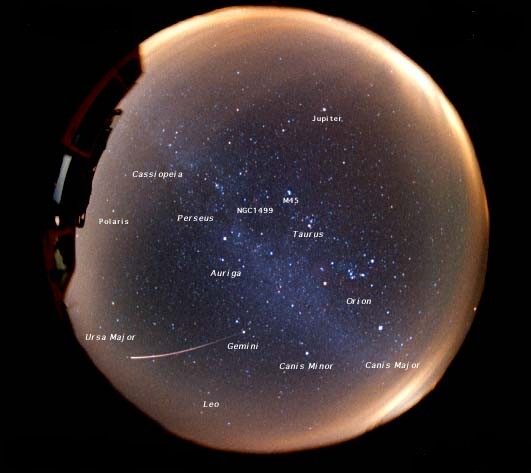Are you ready for one of the most hauntingly beautiful displays of celestial fireworks around? Then be on hand on the night of December 13 through the morning of December 14… Because the Geminids are coming to town!
Somewhere in England in the year 1862, Robert Greg and B.V. Marsh were busy sky watching. Across the sea, so was Professor Alex Twining in the United States. Both were doing independent studies on a little known meteor shower that looked like it was going to become an annual event and the count was on. In those years, the activity was prodigious, the meteor stream didn't produce more than a few per hour, but as studies increases, so did the intensity. In fifteen years, astronomers realized they were on to a full blown meteoroid stream which was producing up to 14 per hour and increasing annually. By 1900 the rate had increased to over 20; and by the 1930s, up to 70 per hour. In the late 1990's observers recorded an outstanding 110 per hour during a moonless night - but just what's to blame for this sharp rise in activity?
Most meteor showers are historic - documented and recorded for hundreds of years - and we know them as originating with cometary debris. But when astronomers began looking for the Geminids' parent comet, they found none. It wasn't until October 11, 1983 that Simon Green and John K. Davies, using data from NASA's Infrared Astronomical Satellite, detected an object (confirmed the next night by Charles Kowal) that matched the orbit of the Geminid meteoroid stream. But this wasn't a comet… it was an asteroid. Originally designated as 1983 TB, but later renamed 3200 Phaethon, this apparently rocky solar system member has a highly elliptical orbit that places it within 0.15 AU of the Sun during every solar system tour. But asteroids can't fragment like a comet - or can they? The original hypothesis placed Phaethon's orbit within the asteroid belt. This means it may have collided with one or more asteroids, creating rocky debris.
While this theory sounded good, but the more we studied the more we realized the meteoroid "path" occurred when Phaethon neared the Sun. So now our asteroid is behaving like a comet, yet it doesn't develop a tail. So what exactly is this "thing?" Well, we do know that 5.1 kilometer diameter Phaethon orbits like a comet, yet has the spectral signature of an asteroid. By studying photographs of the meteor showers, scientists have determined that the meteors are denser than cometary material, yet not as dense as asteroid fragments. This leads them to believe Phaethon is probably an extinct comet which has gathered a thick layer of interplanetary dust during its travels, yet retains the ice-like nucleus. We know that it doesn't outgas so the mystery deepens even more.
In July 1996 the plot thickened even more when astronomers discovered something in the asteroid belt which may have affected 3200 Phaeton - another comet-like asteroid named Elst-Pizarro. On 1996 photographic plates, it displayed a tail, but no coma. Another Phaeton-like mystery? Possibly. Asteroid Elst-Pizarro pretty much makes its home in the main asteroid belt where asteroid-asteroid collisions are bound to happen and when Phaeton passes through every 17 months, the same could have happened to it. Until we are able to take physical samples of this "mystery," we may never fully understand what Phaethon is, but we can fully appreciate the annual display it produces!
Thanks to the wide path of the stream, folks the world over get an opportunity to enjoy the show of the Geminids. The traditional peak time is as soon as the constellation of Gemini appears, around mid-evening. The radiant for the shower is near the bright star Castor - but meteors can originate from many points in the sky. From around 2 AM until dawn (when our local sky window is aimed directly into the stream) it is possible to see about one "shooting star" every 30 seconds. The most successful of observing nights are ones where you are comfortable, so be sure to use a reclining chair or pad on the ground while looking up… And dress warmly! Although the rising Moon will greatly interfere, please get away from light sources when possible - it will triple the amount of meteors you see.
Remember, even if you only spot just a few Geminids each one you see is a wonderful, unique mystery. They are tiny dust particles that measure no more than 10 microns across. What makes them special? Cometary fragments are about 0.3 gm/cc in density while Geminid particles measure more on the 2 to 3 gm/cc, end of the scale. More like rocks than ice. Enjoy the incredible and mysterious Geminids!
Bron: universetoday
Voeg toe aan:








